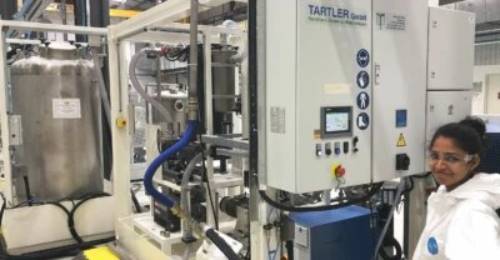Optimizing Mixing and Dosing Processes From the Start
TARTLER‘s T-EVAC degassing system sets standards in material conditioning
The T-EVAC system is the flagship in the range of innovative material degassing stations from the German TARTLER GROUP. It supports quality-enhancing, resource-saving and cost-reducing processing methods across all modern synthetic resin processes and right into many areas of fluid technology. Designed as standard for degassing capacities of up to 1,000 liters per hour, it is also suitable for large-volume consumers.
Whether you think of vacuum infusion or wet pressing, direct infusion or resin transfer molding (RTM) – the TARTLER GROUP degassing stations can meanwhile be used in almost all technologies of modern synthetic resin processing. What’s more, users of other processes in which liquid and pasty media circulate have now also discovered the advantages of these innovative system solutions. At the moment, it is primarily the T-EVAC type evacuation system, which is mostly customized, that has proven to be a pioneering option for quality-enhancing, resource-saving and cost-reducing material conditioning. Numerous synthetic resin processors now use them as a preliminary stage in their dosing and mixing processes, thereby opening up further scope for improving the mixing quality, material efficiency and product quality.

New perspectives for quality optimizers
The T-EVAC is particularly popular in vacuum infusion technology. As in numerous other synthetic resin processing methods, one crucial question is always in the mind of plant operators, product developers and quality optimizers: How can the homogeneity of the material mixtures consisting of different components (resins, hardeners, additives, etc.) be significantly improved? Since this is precisely the focus of TARTLER degassing systems, they make a decisive contribution to the realization of high-quality shaping, application or coating results.
The functionality of the T-EVAC can be illustrated using the example of a synthetic resin processing method where the TARTLER system is currently encountering growing interest: pultrusion technology. In industrial practice, this technology is now a multi-stage process for the production of lightweight profiles or weight-saving molded parts made of carbon or glass fiber reinforced plastic. Passing a fiber reinforcement – fleece, mat or another knitted fabric – through a bath or a mold with a matrix of liquid polyurethane or epoxy resin and various additives is usually one of the first processing steps. The quality of the mixture of resins and additives is of great relevance for the successful cross-linking of the CFRP or GFRP fabric with the matrix. To be on the safe side at this point, the first T-EVAC degassing stations are already being used in pultrusion technology. As before, users are using the opportunity to positively influence the quality of the mixture immediately before application – for example by controlling the dosing/mixing system and selecting the mixing heads and mixing spirals (all of this is also part of the TARTLER portfolio). With the T-EVAC, however, the operators of the pultrusion systems tap into additional potential for process optimization and improvement of the product quality. The reason for this: With a vacuum of <5 mbar (abs.), the T-EVAC removes all air and moisture from the resins and hardeners before processing.

With the components preconditioned in this way, the dosing/mixing system can then create mixtures of high homogeneity reliably and with repeatability, with which high-quality composite-technical results can be reliably achieved in the subsequent pultrusion. Costsaving side effect: Many fillers (e.g. zeolites) previously required in pultrusion technology, which are intended to bind moisture in the resin in order to prevent unwanted reactions, can be partially or even completely omitted. Since the use of such fillers is unpopular anyway – they often act as disruptive factors in fiber impregnation – this also means a simplification and optimization of the process.
Offline or inline?
As standard, the T-EVAC has a PLC control from Siemens (7-inch HMI screen), is primarily designed for the conditioning of epoxy and polyurethane resins and achieves a degassing capacity of up to 1,000 l/h. In addition, it is basically available in two versions: As a central offline station, at which several dosing/mixing systems can be „filled up“ with the degassed components; and as an inline module that can be integrated into a dosing/mixing system. The basic equipment of the T- EVAC includes an automatic vacuum pump protection system and an automatically controlled water heating system with heat recovery. Optionally, there is an automatic water-cooling system, an MX feed system with Kamlok connection for 1,200-liter IBCs and a vacuum buffer tank with a capacity of 1,000 liters. In its role as a special machine builder, TARTLER then takes care of the coordination with the individual process requirements of the customer and all other technical adjustments. As a result, the customer always receives a complete solution tailored to their needs.

TARTLER developed the T-EVAC to offer users in almost all areas of synthetic resin processing an additional tool with which they can decisively optimize their application, coating and shaping processes as well as the quality of their products. The improvements achieved through the use of the vacuum degassing station can be measured and verified and documented in numerous customer applications by TARTLER.
#modernplasticsindia #plasticmagazine #indianmagazine #indianplasticmagazine #modernplasticsaward #ginujoseph #modernplastic #plasticindia #plasticnews #plasticrecycling #modernplasticsglobalnetwork #modernglobalnetwork #modernplasticsaward2023 #PlasticIndustry #modernplasticsgermany #modernplasticsmiddleeast #modernplasticsamerica #modernplasticsbangladesh #modernplasticsasia #modernplasticsitaly #gneuss


